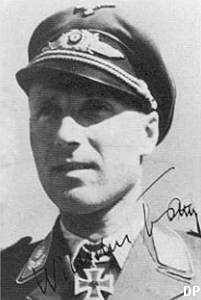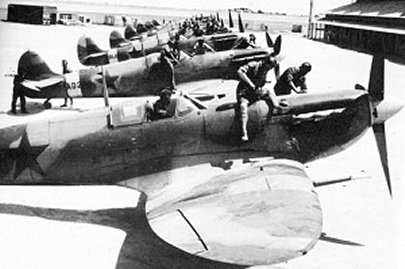
Willi Batz and Air-to-Air Rammings in the Eastern Air War
The Air War on the Eastern Front had many peculiarities. One of them was the phenomenon known as Taran, or air-to-air ramming. Throughout the war, Soviet airmen carried out these self-sacrificing acts on hundreds of occasions. Every Luftwaffe unit operating on the Eastern Front was sustained casualties due to tarans. The moral effect on the German airmen through these rammings was even higher than the actual physical losses. The German fighter ace Willi Batz describes how he on one occasion witnessed such a taran.

Willi Batz
Since early 1943, German Army Group A held the so-called Kuban Bridgehead north of Novorossiysk in northwestern Caucasus. Repeated Soviet attempts to compress the Kuban Bridgehead had been fruitless. On August 7, 1943, the Soviets renewed their attacks, this time concentrated against German 98th Infantry Division at Kiyevskoye, northwest of Krymskaya. But the air was the field where the Germans held the advantage. The whole Fliegerkorps I, mustering nearly 900 German aircraft, was concentrated to the small Kuban Bridgehead. Thus the Germans enjoyed a numerical superiority over the contested Kuban skies.The Soviet aviation still was in no position to challenge the Germans of their air supremacy in this sector.
The most important German fighter unit in the Kuban area was II./JG 52. This Bf 109 G-equipped Gruppe included highly skillful aces such as Oblt. Heinz Schmidt, Ofw. Werner Quast, Fw. Otto Fönnekold, and Hptm. Gerhard Barkhorn. Among upcoming aces were to be found Fw. Heinz Sachsenberg, Fw. Hans Waldmann, Lt. Walter Wolfrum, and an old fighter pilot instructor by the name of Willi Batz, with the rank of an Oberleutnant.
August 7, 1943 was a day filled with heavy air fighting elsewhere on the Eastern Front. When the day was over, the Germans counted 27 own aircraft losses, while 86 Soviet aircraft were claimed shot down. But despite the heavy fighting on the ground at Kuban, August 7 was mainly calm in the air. Early that morning, a formation of 4./JG 52 pilots tangled with a group of Yak-1s, resulting in Ofw. Werner Quast claiming three (for his 82nd through 84th victories) and Lt. Hans-Werner von Rudloff one shot down. But in return, two of the German aircraft were lost, "White 1" and "White 2", and so were both pilots. The latter aircraft was rammed by one of the Yak-1s--the last one that was shot down by Quast--and the German ace ended up in Soviet confinement.
But for most of the day, there was only little air activity. The Soviets conducted a series of swift hit-and-run attacks with Il-2s against the forward German lines. 5./JG 52's ace Fw. Otto Fönnekold paid back by shooting down an Il-2 and one of the Soviet Spitfires that operated in this sector. Spitfires in Soviet service was a special feature for the Soviet aviation in the Kuban sector. These Lend-Lease aircraft had been introduced on the Eastern Front by 57 GIAP at Kuban in the spring of 1943.
Willi Batz took off for the day's first combat mission at 0955 hours. It was a scramble against a report of incoming Soviet aircraft, but no enemy was encountered. This was repeated again two hours later. It was only on the third occasion, late in the afternoon, that Batz came across any Soviet aircraft. And this was not surprising, since by then the German artillery was directed straight against the Soviet troop concentrations by an Fw 189 from Nahaufklärungsgruppe 9. The Fw 189--nick-named Rama ("Frame") by the Soviets, had earned a special hatred among the Soviets. The Fw 189 A-2 piloted by Ofw. Robert Neugebauer--with Stfw. Ernst Kontzke as observer and Uffz. Heinz Kaap as gunner--circled above Kiyevskoye and reported directly to the German artillery. In response, the Soviets scrambled two Spitfires from 4 VA's 821 IAP against the reconnaissance plane. Meanwhile, Il-2 Shturmoviks took off to attack the German artillery.

The Focke Wulf Fw 189
Like on his two previous missions that day, Batz manned the "Black 5" when he took off together with Fw. Otto Fönnekold's four-plane Schwarm from the airfield at Gostagayevskaya at 1720 hours. The Bf 109s climbed while they flew toward the frontline at Kiyevskoye, and after only slightly more than ten minutes they ran into a formation of Il-2s. These were aircraft of the latest type, equipped with rear guns. Fönnekold managed to shoot down one of the ground-attack planes before the combat was over and the remaining Soviet planes had escaped.
The German fighter pilots continued climbing while they circled above the battlefield. They also saw the Fw 189, flying in a southwestern direction and heading toward Kiyevskoye. In that moment, the two 821 IAP Spitfire pilots were approaching the same area, from a higher altitude.

Spitfire Vb fighters made ready for service with the VVS
Led by 21-year old Mladshiy Leytenant Vladimir Lobachyov, the Spitfire Para had shortly before been pulled into combat with two other Messerschmitt 109s at 3,000 meters altitude, probably from the Slovakian 13./JG 52. But since their mission was to intercept the Fw 189, they had withdrawn from that combat--but not before they had expanded all their ammunition. Nevertheless, Lobachyov was determined to destroy the German reconnaissance plane. From a position at around 4,500 meters, Lobachyov saw the Fw 189, but also realized the four Bf 109s. He realized that he had only one chance, and that surprise was the only factor that could lead to success. He shoved the stick forward and his Spitfire Vb with red stars on wings and fuselage started diving toward the Rama.
The German fighter pilots caught sight of the two diving Spitfires--erroneously identifying them as "Airacobras"--too late to interfere. We will never know if the Fw 189 pilot Ofw. Robert Neugebauer and his crewmembers ever saw what struck them--they all were listed as missing. Willi Batz recounted:
I saw two Airacobras come diving steeply from high above in order to attack the Fw 189. I opened fire against the attacking pair from too large a distance and saw how one of the Airacobras flew straight into the Fw 189, thus ramming it. The second Airacobra made a sharp turn to the left and tried to attack the crewmembers of the Fw 189, who had bailed out. I managed to open fire against the Airacobra while I was turning, and saw shrapnel fly from the aircraft and the cockpit started burning. The pilot bailed out and the Airacobra was destroyed as it hit the ground.
Lobachyov's Spitfire chopped off the Fw 189's tail plumage, and the successful Soviet fighter pilot was lucky enough to survive and bail out. And so were, as seen also through Batz's account, the German flight crew. According to the Soviet report, Lobachyov found the three parachuted German airmen on the ground. After a short exchange of fire, during which one of the Germans was wounded by a bullet from Lobachyov's flight pistol, Soviet troops arrived to capture the enemy fliers.
The Spitfire that Batz shot down was recorded as Willi Batz's 12th aerial victory. Batz would survive the war, bringing his total tally to 237 victories. He passed away on September 11, 1988.
Willi Batz, Flugbuch.
Meldungen über Flugzeugunfälle und Verluste bei den fl. Verbänden (täglich), Ob.d.L. Gen.Qu. Gen. 6. Abt., Bundesarchiv/Militärarchiv, Freiburg.
JG 52 Abschussberichte via Alfons Altmeier.
Interview with Willi Batz.
Antipov, Patriots or Red Kamikaze?
TsAMO, f. 821 IAP.
TsAMO, f. 32, op. 11318, d. 62, l. 212.
Note: The above is an excerpt from material in forthcoming Black Cross/Red Star volumes.
Volume 3 of Black Cross/Red Star is completed and is prepared for publication by Eagle Edition in 2004. Click here for more information
© Christer Bergström 2003 ©
Back to Main Page